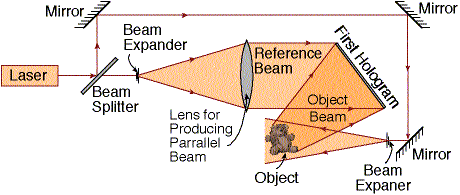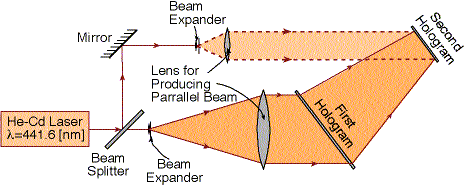Rami Arieli: "The Laser Adventure" Chapter 10 Section 3, page 18
Recording Stages
of Rainbow Hologram:
-
Recording regular transmission hologram
using high quality parallel reference beam (Hologram 1 in figure 10.10).

Figure 10.10a: Recording H1 of "Rainbow hologram".
This first hologram is served as a Master
hologram (H-1) for replication. The image of this hologram
is used as the object for the second hologram (H-2).
Illuminating H-1 hologram is done using laser light passing
through a narrow horizontal (1-2 [mm]) slit placed on the original hologram
(This is the process of canceling the vertical
parallax).
-
Using the reference beam to illuminate the hologram (H-1) from the opposite
side of the original reference beam. This create a real
image of H-1 in air (not on screen), the same size as
the original body (see figure 10.10b).

Figure 10.10b: Recording H2 of "Rainbow hologram".
The beam from the master hologram serves as an object beam for the second
hologram, and interacts with a new reference beam. The second hologram
(H-2) is a record of the real image of H-1, without vertical parallax,
on a photoresist (light sensitive material).
-
After recording the second hologram (H-2), the photoresist is electroplated
by metal (Ni)
at a width of 0.5-1.25 [mm].
-
After separating the metal (Ni) layer from the photoresist, the metal
master plate containing the mirror image of the second
hologram (H-2) is used in hot pressing process to transfer the information
into plastic sheets. The metal master
is used as metal plated stamping die.
The plastic sheets are coated in vacuum with aluminum,
which contain the mirror image of the Ni plate, which is the original information
on the second hologram.
The production technique is called embossed
holography.


